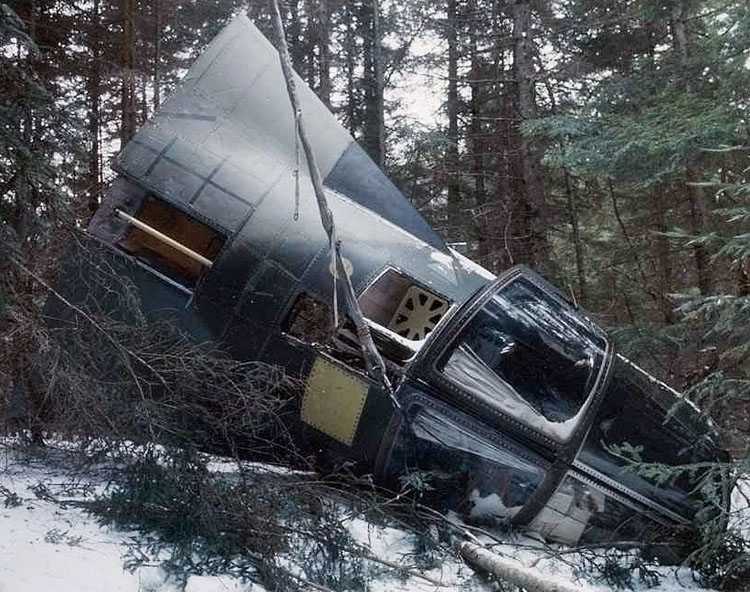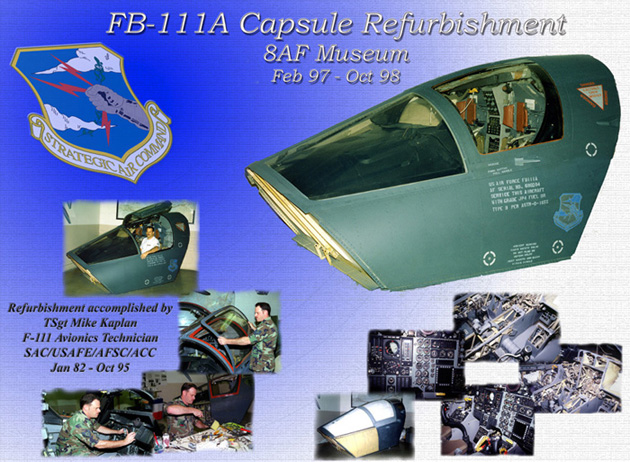

On 2 February 1989, FB-111A 68-0243 left Plattsburgh AFB on a routine training mission at 10:50 a.m. The planned mission included refueling with a Plattsburgh KC-135 aerial tanker and low-level training over Maine. Shortly after take-off, the pilot, Capt.Randy Voorhees and his navigator, Capt.Len Esterly discovered a problem with the left external fuel tank. Based on the crew's observations, the tank appeared to be cocked approximately 10 degrees outboard, toward the left wing tip. About one-half into their mission, the crew decided to return to Plattsburgh AFB. At 11:43 a.m., they requested and received permission to descend from 19,000 feet to 10,000 feet where Capt. Voorhees planned to test the aircraft's controls in the landing configuration. While preparing for the check, the FB-111A experienced a heavy lift yaw and an almost simultaneous left roll. According to the crash report, it is likely that this manuever was caused by a further rotation of the fuel tank. Although the crew attempted to regain control of the bomber, during the third roll, Capt. Voorhees gave the order to "bail out". At that point the capsule separated and parachuted into a wooded area approximately eight-tenths of a mile north of where the aircraft crashed. The aircraft, flying approximately 60 degrees nose low inverted, crashed at 11:47 a.m. at the 1,100 feet point of a 1,600 feet hill, 1 and three-quarters miles northeast of St-Johnsbury, Vt. The report states that the crew, although following all known procedures, was unable to maintain control of the aircraft. The investigation centered on the attachment of the fuel tank to the wing. The fuel tank is connected to the wing by an assembly which allows the tank to rotate as the FB-111's wing sweep forward and back. Post accident testing and teardown revealed abrasions on the adaptor bellcrank housing which indicated that the adaptor and pylon had rotated 65 degrees to the left prior to the time of impact. The lack of significant damage at the bases and sides of the teeth indicate they had been disengaged or partially engaged at the time of impact. Although the locking mechanism was in place, evidence indicated that either the teeth had not been engaged properly at the time of installation or the lock ring could have unscrewed itself in flight.The crash report was released on June 15, 1989 and completed a five month investigation of the crash. The board's findings concluded that a cocked external fuel tank resulted in the aircraft accident. Both crewmembers ejected safely with the capsule and were not injured.
(Left to right) 68-0263 in storage at the USAF Museum and the capsule on display at the 8th AF Museum
The crew module system.The crew module is integrated into the FB-111A aircraft encompassing the pressurized cabin and forward portion of the wing glove. Two crew seats with restraints are positioned side by side in the crew module. Freedom of movement and comfort are enhanced by precluding the necessity for a personal parachute and survival equipment, these are provided as a part of the crew module system. During an emergency, the crew module is separated from the aircraft and propelled to a height sufficient for successful recovery throughout the aircraft performance envelope. Upon land or water impact of crew module, landing shock reduction is provided. The crew module system also is provided with self-righting buoyancy, flotation capacity, and occupant environmental hazard protection. An emergency oxygen supply is a portion of the crew module system.
Ejection sequence
For crew escape and survival, the crew module system is composed of many systems (initiation, severance, separation, stabilization, recovery, landing, flotation, survival, seat and restraint, and emergency oxygen). The systems are interconnected by means of shielded mild detonating cord (SMDC), a stimulus transfer medium. To ensure proper sequencing of functions, SMDC is provided with time delay initiators and one-way explosive transfers. Explosive transfer connectors are incorporated in the systems for firing redundancy. After actuation of the initiation system, automatic sequencing of all systems through landing and flotation is provided.During an emergency, ejection is initiated by manually actuating either of the ejection handles to fire dual ejection initiators and, in turn, to detonate the SMDC. Due to SMDC detonation, both upper restraint harness are retracted by the inter-lock reel power retraction devices; secondary controls guillotine, blade antenna leads guillotine, and leading edge antenna leads guillotine are activated; and the emergency oxygen system is actuated. Control cables, oxygen line, and antenna leads are severed by the guillotines. Upon propagation through a mechanical explosive interrupt and a 3-second time delay initiator, the chaff dispenser and radio beacon set is actuated.After 0.350 second, the rocket motor is ignited, if not already actuated, the guillotines, emergency oxygen systems and chaff dispenser are activated by one set of SMDC. By the sane set of SMDC, a flexible linear-shaped charge (FLSC) of the severance system is detonated, thereby cutting the crew module free of the aircraft and the stabilization-brake parachute cover free of the crew module. At the same moment the FLSC cuts the crew module free of the aircraft, the rocket motor propels the crew module upward and away from the aircraft.By shock wave propagation through SMDC, the stabilization-brake parachute catapult is fired after a 0.15-second delay. At ejection speeds below 300 knots, the dual-mode q-actuated selector prevents propagation to the rocket motor upper nozzle cone diaphragm and activates the barostat lock initiators in 1.0 seconds. At all ejection speeds above 300 knotts, the barostat lock initiator cannot be activated through the dual-mode q-actuated selector. However, propagation is continued to the rocket motor upper nozzle diaphragm through the q-actuated selector and a 0.15 second time delay initiator. After a 1.6-second time delay and after the forward component of acceleration decays to 2.2 G's, the g-sensor initiator is fired to activate the barostat lock initiator. Another explosive train with time delay initiator is provided to ensure that activation time of barostat lock initiator is never more than 4.4 seconds.Upon activation of the barostat lock initiator, the aneroid bellows are released to begin functioning, and the firing pins are released to bellows control. The firing pins are retained by the bellows until the crew module falls to between 14,000 and 16,000 feet. When the barostat lock initiator firing pins are released, detonation propagation is continued to the recovery parachute cover FLSC and the recovery parachute catapult. The cover and catapult are fired simultaneously, causing the catapult to deploy the recovery parachute. Following a 3-second delay, detonation propagation is continued to sever the impact attenuation bag severance cover. Concurrently with cover severances, the impact attenuation pressure sources are actuated by puncturing a disk in each sealed pressure bottle by means of explosive valves. The impact attenuation bag is inflated by air from the impact attenuation pressure source through a pressure regulator. After a 7-second delay, the recovery parachute repositioning retractor is activated and the recovery parachute forward and aft bridles are deployed, permitting the crew module to assume landing position. Concurrently with the firing of the repositioning retractor, the emergency UHF antenna actuator is fired and the antenna is extended. Upon landing, shock is attenuated by controlled deflation of the impact attenuation bag. Controlled deflation is accomplished by blowout plugs which shear retainers upon impact, allowing air to escape from the impact bag.Upon landing in water, the severance and flotation handle is actuated to provide inflation of self-righting and aft flotation bags. However, if the crew module is still attached to a ditched aircraft, the severance and emergency oxygen systems are actuated by the severances and flotation handle. Detonation shock wave from the severance-flotation initiator is propagated through SMDC to FLSC that cuts covers from the crew module. The pressure source is activated to release compressed gas to inflate the aft flotation and left self-righting bags. The crew module is allowed to surface and, if inverted, to begin rolling to the upright position with aid of the left self-righting bags. After a 75-seconds delay, the pressure source is activated to inflate the right self-righting bag, thereby pushing the crew module to the upright position. The recovery parachute release retractors are fired by by actuation of the recovery parachute release handle to disconnect both recovery parachute bridles from attachment to the crew module. The auxiliary flotation bag is deployed by pulling the auxiliary flotation handle on the auxiliary flotation and parachute deploy initiator located on the canopy center beam.
Note: The information presented on this page were taken from an "OJT Instructor Guide". This handbook was developed by the 436th Strategic Training Squadron / OL-PL for FB-111A maintainers. It was conceived as a training aid and had the advantage of having a lot of general infos in one book. Its only purpose was to give quick reference, as far as systems, operations, functions, etc... The pressures, readings and limitations were subject to change, and were used only to provide general parameters.
"FB" Capsule restored at 8AF Museum, Barksdale AFB LA. I totally stripped this F-111E capsule, including instrument panel frames, basically stripped FB-111A 68-0284 capsule that is on display outside the museum, and made this capsule an FB. Only thing I could NOT install in here was the ARS tracking handle, could not get it out of the FB! This project took me my entire 1st tour at Barksdale to accomplish, 2 1/2 yrs! This is on display in the History of Aerial Bombardment Gallery at the Eighth Air Force Museum. Go check it out, and recently created a Facebook page with the same name, Eighth Air Force Museum! I am "crew chief" and "owner!" of both the FB and the Capsule. Also member of 8AF Museum Association. Also repainted the FB twice! By Mike Kaplan.
